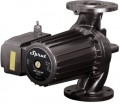Max. flow
The maximum flow of a pump is the amount of liquid it can pump in a certain amount of time.
Features of choosing the optimal performance option depend primarily on the purpose of the pump (see above). For example, for DHW recirculation models, the pump performance should not exceed the performance of the water heater. If the water heater is capable of delivering 10 litres per minute to the DHW circuit, then the maximum pump performance will be 10*60=600 L/h. The basic formula for calculating the performance of a heating system takes into account the power of the heater and the temperature difference at the inlet and outlet, and for the cold water system — the number of points of water intake. More detailed information about the calculations for each application can be found in special sources, and it is better to entrust the calculations themselves to professionals.
Max. head
The head can be described as the maximum height to which a pump can lift liquid through a vertical pipe without bending or branching. This parameter is directly related to the pressure that the pump produces: 10 m of head approximately corresponds to a pressure of 1 bar (do not confuse this parameter with operating pressure — see more about it below).
The head is one of the key specs for most circulation pumps. Traditionally, it is calculated based on the difference in height between the location of the pump and the highest point of the system; however, this principle is relevant only for units that
boost the pressure of cold water(see "Suitable for"). Circulation pumps for heating and DHW work with closed circuits, and the optimal pressure depends on the total hydraulic resistance of the system. Detailed calculation formulas for the first and second cases can be found in special sources.
Minimum fluid temperature
The lowest fluid temperature at which the pump is capable of operating normally.
Almost all pumps can normally transfer cool water, regardless of the purpose (see above); therefore, for normal household use, this parameter is not critical and for some models, it may not be indicated at all. But if you need the ability to work with liquids with temperatures below 15 °C, you should pay close attention to the minimum temperature. Some models that can be used with antifreeze normally tolerate even temperatures below zero.
Max. power consumption
The electrical power consumed by the pump during normal operation and maximum performance.
This indicator directly depends on performance — after all, for pumping large volumes of water, an appropriate amount of energy is needed. And the power depends on two main parameters — electricity consumption and the load on the power grid, which determines the connection rules. For example, pumps with a power of more than 5 kW cannot be connected to ordinary household sockets; more detailed rules can be found in special sources.
Shaft material
It is the material from which the motor shaft in the pump is made.
— Cermet. It is a material that combines metals and their alloys with non-metallic components. In modern pumps, different types of cermets can be used, differing in price and quality; usually, the features in each case directly depend on the price category of the unit. However, it is well suited for household models with relatively low performance but is poorly suitable for professional use. Therefore, in pumps of more than 15,000 litres per hour, cermet shafts are rarely used.
— Stainless steel. This material is highly durable and reliable, due to which it is found in almost all categories of pumps — from relatively simple to professional, the performance of which is in the tens of thousands of litres per hour. However, it is somewhat more expensive than cermets.
Impeller material
It is the material from which the impeller is made. It is the main part of the pump, which provides pressure due to movement.
—
Plastic. This material is inexpensive in itself, and it is easy to process, due to which it is distinguished by low cost. In addition, plastic is not subject to corrosion. On the other hand, it is considered the least reliable of all materials used in modern pumps and, therefore, is used in relatively inexpensive models that are not designed for serious loads. The exception to this rule are special high-strength polymers but they are rare.
—
Stainless steel. As the name suggests, stainless steel is virtually corrosion-resistant. However, this is not its only advantage — this material is very durable and reliable, and due to this, it is used even in powerful high-performance models.
—
Cast iron. This material is in many ways similar to steel — in particular, it is considered very reliable — but it has a slightly higher weight. On the other hand, in most cases, this is not a noticeable drawback, but cast iron costs a little cheaper than stainless steel.
—
Brass. An alloy based on copper and zinc which has a golden colour. The varieties used in circulation pumps are highly resistant to corrosion, they surpass even stainless steel. Therefore, this option is well suited for
...water with a high oxygen content. The disadvantage of brass can be called a rather high cost.Port-to-port length
The installation length is the distance between the inlet and outlet of the pump, in other words, the length of the segment occupied by the pump in the circuit. This parameter allows you to estimate the amount of space required for the unit, and determine the length of the pipe section that needs to be cut.

